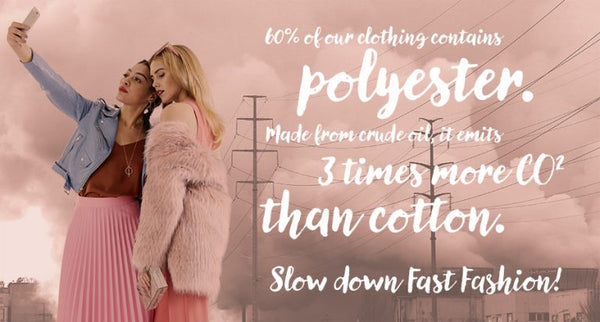Photo Credit: Greenpeace Detox Campaign
We applaud you for refusing plastic straws in your cocktails and iced coffees! Our heart warms when we see people filling their reusable metal bottles at water fountains instead of buying disposable plastic ones. However, there is one giant piece of plastic that never gets a second look and we are sitting in it, walking around in it and sometimes having intimate relationships with it.
It’s polyester-- the plastic no one wants to talk about.
Because if we started talking about it, as a consumer you might really start to look at your labels and realize that everything in your yoga, workout, performance and ‘athleisure’ wardrobe is made with petroleum. Derived from crude oil, the most common type of polyester is PET, a plastic used to make ketchup bottles.

Photo Credit: Greenpeace Detox Campaign
Polyester is sneaky. It can show up in a blend of fibers and mimic silk, cotton or linen. If you have been shopping vintage or rewearing your old threads, it might not show up as much. If you are shopping the current trends, it’s hard to avoid.
Polyester is having it’s time as the dominant fiber in the world because it is profoundly cheaper than a natural fiber which translates into incredible profit margins. Did you know that fashion executives are not counted among the world’s richest people - even ahead of oil executives?

Photo Credit: Quartz media
The only problem is that polyester is choking the world. The manufacturing of polyester creates 3x more carbon emissions than cotton. It is not biodegradable at all. Every single cheap piece of clothing will live in landfills for hundreds of years after you pass away.
And if that isn’t bad enough - even while you are using it - it is killing our waterways and oceans. According to Plastic Soup, an research group studying the effects of microplastic on our oceans, each time you wash your polyester clothing and workout gear, up to 9000 particles are being released into our waterways. Eventually they contribute to creation of ‘dead zones’ in the ocean, devoid of aquatic life.
“It’s estimated that there are 1.4 million trillion microfibers already in our oceans. That’s like 200 million microfibers for every person on the planet”
- The Story of Stuff Project
When will consumers say no to this toxic cloth?
It’s not just the sea creatures who are suffering. Microplastic polyfibers from clothing are in 83% of the world’s drinking water. Even if you don’t care about landfills or the oceans, take a moment to consider your own delicate ecosystem.
Leave a comment